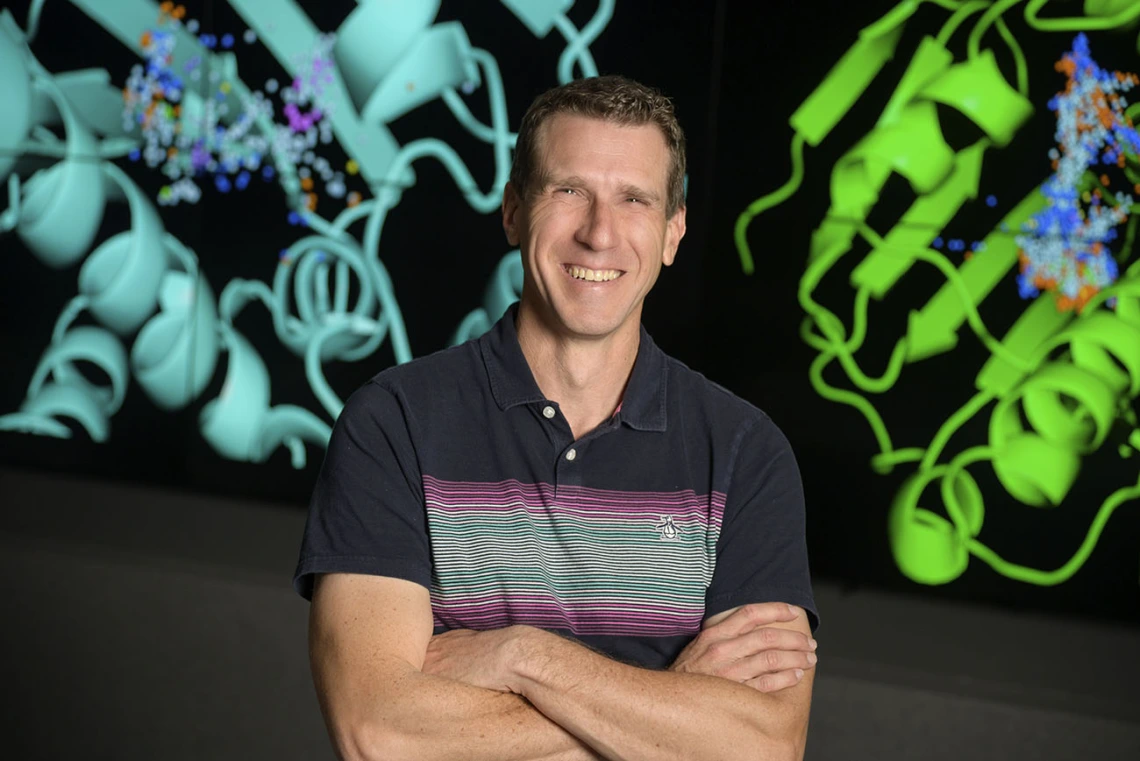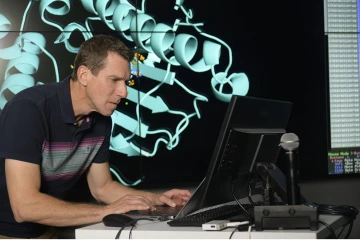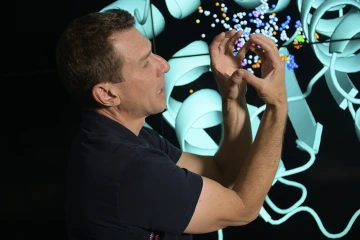Computational drug discovery could open new doors
New computational approaches to drug development could lower treatment costs and make new discoveries possible.

Travis Wheeler, PhD, and his team at the University of Arizona Health Sciences are developing software to aid in identifying drugs for target proteins and for predicting possible side effects.
Imagine you have a key chain with four keys on it, and the locksmith down the road has a key chain with 500 keys. You would be able to open some doors and the locksmith would be able to open more, but neither of you will be able to open every door you come across.

Travis Wheeler, PhD, has more than 25 years of experience in designing algorithms, statistical models and software for problems motivated by biological data.
This is similar to the practical challenges pharmaceutical researchers face when discovering new therapeutics. Historically, scientists physically tested a collection of thousands of candidate drugs to see what effects they have. Over time, computational approaches have made the process more efficient, but advancement has needed to be faster, and drug discovery is still considered to be time consuming and expensive.
Travis Wheeler, PhD, and his team at the University of Arizona Health Sciences are developing cutting-edge machine learning techniques that they expect will bring costs down and make new discoveries possible. He uses the analogy of finding a key for a locked door.
“You and the locksmith might find a company that could provide you with 500,000 keys, but that would take a long time to try one by one manually,” said Dr. Wheeler, associate professor in the R. Ken Coit College of Pharmacy. “Our technology is like being able to take a picture of the lock you want to open and having a computer rapidly scan through hundreds of thousands of keys to provide you with a few worth trying on the door.”
Providing researchers with computational tools
Most people only think about protein when looking at a nutrition label, but every human can thank tens of thousands of proteins for making their life possible. Every cell in the body stays alive and performs its necessary functions by producing and organizing proteins. Proteins are key players in different stages of disease progression and are critical to the functions of viruses.
When proteins do not work as expected or when bacteria or viruses produce proteins that interfere with the workings of cells, drugs can be used to set things right. A drug is simply a small molecule that fits into a targeted protein, much like a key might fit into a lock.

Janko Nikolich, MD, PhD, leads two UArizona Health Sciences initiatives. One focuses on creating defenses against disease and the other envisions a pandemic-free future.
“A protein folds into a three-dimensional structure with little pockets or cavities that allow it to bind to something. The key-in-lock interaction is called drug binding and produces results by changing something about how the protein works,” Dr. Wheeler said. “This is where drug discovery comes in. For example, if you find a pocket that a virus needs for replicating itself, you might be able to pour something into it and stop it from replicating.”
Unlike some health sciences researchers, Dr. Wheeler’s group centers more on computation than the human body. They develop algorithms, machine learning methods and software implementations, then direct those tools toward problems that often arise when analyzing biological data.
“A lot of what we do is build tools that biologists of all stripes can use to understand what are the contents of a genome or what are the functional parts of proteins. One natural offshoot of that work is drug discovery,” Dr. Wheeler said.
To make drug discovery a more efficient process, Dr. Wheeler's team is developing software to identify drugs for target proteins and predict possible side effects. Similar to how an advanced search engine works, the computer learns from hundreds of thousands of examples to gain insight into the process of drug binding. The software will be able to rapidly scan billions of small molecules for expected interactions and recognize relationships between chunks of protein sequences. This could lead to novel treatments and address issues related to infection, immunity and inflammation.
“We hear a lot about machine learning and artificial intelligence and how this will change many fields of life, including health and cures for diseases,” said Janko Nikolich, MD, PhD, head of the UArizona College of Medicine – Tucson’s Department of Immunobiology and director of the Aegis Consortium. Dr. Nikolich leads a UArizona Health Sciences initiative to create defenses against disease, which is funding some of Dr. Wheeler’s drug discovery efforts. “Dr Wheeler’s work will put this into practice, and help us fast-discover new drugs to, for example, stop the next pandemic or treat currently untreatable chronic diseases.”
Helping more patients

Projects in Dr. Wheeler's research group range from statistical modeling of biological sequence families to text indexing, bounded search algorithms and low-level software optimization, and from deep neural networks and natural language processing and related machine learning methods to development of databases and accompanying web services.
According to Dr. Wheeler, advancements in computational drug discovery are particularly important for diseases that do not produce profitable revenue streams for pharmaceutical companies. For very large drug searches, physical discovery can cost tens of millions of dollars to find a potential drug target. When dealing with a condition that affects millions of people, such as hypertension, pharmaceutical companies have incentive to spend that upfront cost. But for rarer conditions or for those that mainly affect impoverished populations, that upfront cost can be a barrier to finding therapeutics.
“These computational approaches explore a much wider diversity of candidate molecules. That increases the chance that you will be able to find something that otherwise would not have been found, and it can be done much cheaper and much faster,” Dr. Wheeler said. “Potential cures might be identified for smaller groups, and the price of those drugs could be more affordable.”
Dr. Wheeler said his work in computer science has always been driven by intellectual curiosity and the rewarding feeling of solving complex puzzles. His computational drug discovery work delivers those feelings with the added benefit of being able to help people.
“I’ve got the best job in the world,” he said. “A lot of people buy books filled with word or number puzzles. But instead of needing to buy those, I get paid to work out solutions to really complicated problems. It’s also rewarding because I’m able to use these computational and statistical methods that I have learned to potentially make an impact on someone’s life or on the state of human health in general.”
Our Experts
Travis Wheeler, PhD
Associate Professor, R. Ken Coit College of Pharmacy
Janko Nikolich, MD, PhD
Professor and Head, Department of Immunobiology, College of Medicine – Tucson
Co-Director, Arizona Center on Aging
Director, AEGIS Consortium
Professor, Medicine
Professor, Nutritional Sciences
Member, BIO5 Institute
Member, Cancer Biology Program, UArizona Cancer Center
Contact
Brian Brennan
Health Sciences Office of Communications
520-621-3510
brianbrennan@arizona.edu

